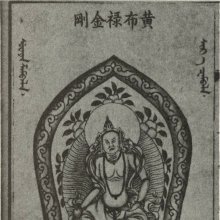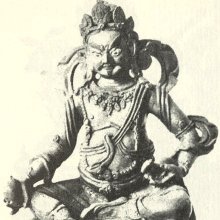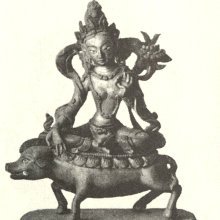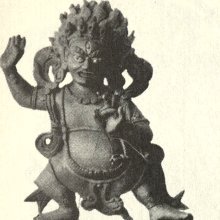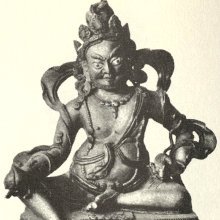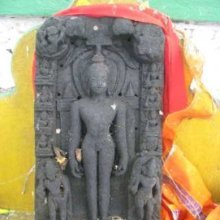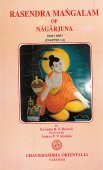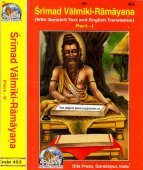Pita, Piṭa, Pitā, Pīta, Pītā, Piṭā: 40 definitions
Introduction:
Pita means something in Buddhism, Pali, Hinduism, Sanskrit, Jainism, Prakrit, Marathi, Hindi, biology, Tamil. If you want to know the exact meaning, history, etymology or English translation of this term then check out the descriptions on this page. Add your comment or reference to a book if you want to contribute to this summary article.
Images (photo gallery)
(+5 more images available)
In Hinduism
Ayurveda (science of life)
Nighantu (Synonyms and Characteristics of Drugs and technical terms)
Source: WorldCat: Rāj nighaṇṭuPītā (पीता) is another name for Tejovatī, a medicinal plant similar to Jyotiṣmatī Celastrus paniculatus (black oil plant or intellect tree) from the Celastraceae or “staff vine” or “bittersweet family” of flowering plants, according to verse 3.82 of the 13th-century Raj Nighantu or Rājanighaṇṭu. The Raj Nighantu reads Jyotiṣmatī and Tejovatī together while Bāpālāl identifies Tejovatī with Zanthoxylum budrunga (cape yellowwood or Indian ivy-rue) from the Rutaceae or “rue” or “citrus” family. The third chapter (guḍūcyādi-varga) of this book contains climbers and creepers (vīrudh). Together with the names Pītā and Tejovatī, there are a total of thirty-one Sanskrit synonyms identified for this plant.
Unclassified Ayurveda definitions
Source: Wisdom Library: Āyurveda and botany1) Pīta (पीत) is a Sanskrit technical term translating to the color “yellow” and is used throughout Ayurvedic literature such as the Suśrutasaṃhita or the Carakasaṃhita.
2) Pīta (पीत) is another name for Śākhoṭa, which is a Sanskrit word referring to Streblus asper (Siamese rough bush), from the Moraceae family. It is classified as a medicinal plant in the system of Āyurveda (science of Indian medicine) and is used throughout literature such as the Suśrutasaṃhita and the Carakasaṃhitā. The synonym was identified in the Rājanighaṇṭu (verse 9.123), which is a 13th century medicinal thesaurus.
3) Pīta (पीत) is another name (synonym) for Kusumbha, which is the Sanskrit word for Carthamus tinctorius (safflower), a plant from the Asteraceae family. This synonym was identified by Narahari in his 13th-century Rājanighaṇṭu, which is an Ayurvedic medicinal thesaurus. Certain plant parts of Kalamba are eaten as a vegetable (śāka).
Source: gurumukhi.ru: Ayurveda glossary of terms1) Pīta (पीत):—Yellow colour
2) A liquid dosage form

Āyurveda (आयुर्वेद, ayurveda) is a branch of Indian science dealing with medicine, herbalism, taxology, anatomy, surgery, alchemy and related topics. Traditional practice of Āyurveda in ancient India dates back to at least the first millenium BC. Literature is commonly written in Sanskrit using various poetic metres.
Purana and Itihasa (epic history)
Source: Cologne Digital Sanskrit Dictionaries: The Purana Index1) Pitā (पिता).—A son of Brahmadhāna.*
- * Vāyu-purāṇa 69. 132.
2) Pīta (पीत).—The Vaiśya caste of Śālmalidvīpa.*
- * Viṣṇu-purāṇa II. 4. 30.

The Purana (पुराण, purāṇas) refers to Sanskrit literature preserving ancient India’s vast cultural history, including historical legends, religious ceremonies, various arts and sciences. The eighteen mahapuranas total over 400,000 shlokas (metrical couplets) and date to at least several centuries BCE.
Natyashastra (theatrics and dramaturgy)
Source: Wisdom Library: Nāṭya-śāstraPīta (पीत, “yellow”) refers to one of the found original (natural) colors (varṇa), according to Nāṭyaśāstra chapter 23. From these colors come numerous derivative and minor colors (upavarṇa).
According to the Nāṭyaśāstra, “Budha (Mercury?) and Hutāśana (Agni) should be painted yellow (pīta)”.
Source: Shodhganga: Elements of Art and Architecture in the Trtiyakhanda of the Visnudharmottarapurana (natya)Pīta (पीत) or “yellow (colour)” is associated with Adbhuta or the “wonderful sentiment”, which represents one of the nine kinds of Rasa (“soul of Drama”), according to the Viṣṇudharmottarapurāṇa, an ancient Sanskrit text which (being encyclopedic in nature) deals with a variety of cultural topics such as arts, architecture, music, grammar and astronomy.—According to the Viṣṇudharmottarapurāṇa, Adbhuta is the sentiment that arises from wonder. Vismaya is the sthāyibhāva of adbhuta-rasa. Pīta i.e., yellow is the colour and Brahma is the god of this sentiment. The Viṣṇudharmottarapurāṇa states that adbhutarasa arises from vīrarasa.

Natyashastra (नाट्यशास्त्र, nāṭyaśāstra) refers to both the ancient Indian tradition (shastra) of performing arts, (natya—theatrics, drama, dance, music), as well as the name of a Sanskrit work dealing with these subjects. It also teaches the rules for composing Dramatic plays (nataka), construction and performance of Theater, and Poetic works (kavya).
Nirukta (Sanskrit etymology)
Source: Journal of the American Oriental Society: Sanskrit Pīta and Śaikya/saikyaPīta (पीत) is the past participle of the verb √pā, “drink”, and refers to the treatment of “iron” with a liquid bath, i.e., the quenching of carburized iron effectively a low-carbon steel).
Nirukta (निरुक्त) or “etymology” refers to the linguistic analysis of the Sanskrit language. This branch studies the interpretation of common and ancient words and explains them in their proper context. Nirukta is one of the six additional sciences (vedanga) to be studied along with the Vedas.
Jyotisha (astronomy and astrology)
Source: Wisdom Library: Brihat Samhita by VarahamihiraPīta (पीत) refers to the “yellow” type of solar spots (ketus), according to the Bṛhatsaṃhitā (chapter 3), an encyclopedic Sanskrit work written by Varāhamihira mainly focusing on the science of ancient Indian astronomy astronomy (Jyotiṣa).—Accordingly, “The dark spots, also known as ketus, the sons of Rāhu are Tāmasa, Kīlaka and the like, and are 33 in number. How they affect the earth depends upon their color, position and shape. [...] A single spot will bring on famine; if two or more spots should appear, the reigning prince will die; if they should appear white, red, yellow [i.e., pīta] or black then the Brāhmaṇas, the Kṣatriyas, the Vaiśyas or the Śūdras will suffer respectively. Only those parts of the earth will suffer in the corresponding parts of which on the solar disc the spots happen to appear”.

Jyotisha (ज्योतिष, jyotiṣa or jyotish) refers to ‘astronomy’ or “Vedic astrology” and represents the fifth of the six Vedangas (additional sciences to be studied along with the Vedas). Jyotisha concerns itself with the study and prediction of the movements of celestial bodies, in order to calculate the auspicious time for rituals and ceremonies.
Shaivism (Shaiva philosophy)
Source: Brill: Śaivism and the Tantric TraditionsPīta (पीत) refers to “yellow”, as quoted by Hṛdayaśiva in his Prāyaścittasamuccaya (verse 10.27-35).—Accordingly, “[...] Wearing yellow garments (pītavāsa) and yellow (pīta) garlands and unguents and a yellow (pīta) sacred thread he should perform the excellent observance of rudrāṇī for a month. The competent ritualist, constantly devoted to the worship of Śiva, should perform the observance for puruṣṭuta for one month with all accoutrements being black. [...]”.
Source: SOAS University of London: Protective Rites in the Netra TantraPīta (पीत) refers to “yellow”, according to the Netratantra of Kṣemarāja: a Śaiva text from the 9th century in which Śiva (Bhairava) teaches Pārvatī topics such as metaphysics, cosmology, and soteriology.—Accordingly, [verse 11.1-24ab, while describing the appearance and worship of Tumburu]—“[...] The Devīs are white, red, yellow (pīta), and black, four-faced, four armed, three eyed, and in [their] hands bear golden hatchets, sticks and rosaries. [...] Mounted on a corpse, Jayā devī shines forth [in white]; four-armed, four-faced, three-eyed, red Vijayā holds grass, a bow, a shield and a sword, [while] standing upon an owl, O Devī. [...] [When one] worships and meditates on [the Devīs, as they] stand in the cardinal directions, [the Devīs grant the practitioner] the fruits of siddhi. [...]”.

Shaiva (शैव, śaiva) or Shaivism (śaivism) represents a tradition of Hinduism worshiping Shiva as the supreme being. Closely related to Shaktism, Shaiva literature includes a range of scriptures, including Tantras, while the root of this tradition may be traced back to the ancient Vedas.
Vaishnavism (Vaishava dharma)
Source: Brill: Śaivism and the Tantric Traditions (vaishnavism)Pīta (पीत) refers to “yellow-ochre (robes)”, according to the Vedānta Deśika’s Yatirājasaptati.—When we come to the poem’s understanding of the divinity of Rāmānuja we find a wide spectrum of meanings. [...] Finally, in verse 63 Rāmānuja is Viṣṇu himself in his form (mūrti) as Dattātreya, with his yellow-ochre robes (pīta-vasana) and protective ascetic rod.

Vaishnava (वैष्णव, vaiṣṇava) or vaishnavism (vaiṣṇavism) represents a tradition of Hinduism worshipping Vishnu as the supreme Lord. Similar to the Shaktism and Shaivism traditions, Vaishnavism also developed as an individual movement, famous for its exposition of the dashavatara (‘ten avatars of Vishnu’).
Pancaratra (worship of Nārāyaṇa)
Source: University of Vienna: Sudarśana's Worship at the Royal Court According to the AhirbudhnyasaṃhitāPīta (पीत) refers to “yellow (garments)”, according to the Ahirbudhnyasaṃhitā, belonging to the Pāñcarātra tradition which deals with theology, rituals, iconography, narrative mythology and others.—Accordingly, “One desirous of a kingdom, one who has been deprived of it or one conquered by [other] rulers, after having paid respect with large masses of wealth to the supreme Guru, the giver of Sudarśana’s Yantra, considering [him] superior to all, should propitiate God Nārāyaṇa—who has large eyes like lotuses, is [of] dark [complexion], clad in a yellow garment (pīta-vasana), adorned with all ornaments and with four arms - following the rules given by the teacher. [...]”.

Pancaratra (पाञ्चरात्र, pāñcarātra) represents a tradition of Hinduism where Narayana is revered and worshipped. Closeley related to Vaishnavism, the Pancaratra literature includes various Agamas and tantras incorporating many Vaishnava philosophies.
Ganitashastra (Mathematics and Algebra)
Source: archive.org: Hindu MathematicsPīta (पीत) or Pītaka refers to the “color yellow” which were used as symbols for the unknowns, according to the principles of Bījagaṇita (“algebra” or ‘science of calculation’), according to Gaṇita-śāstra, ancient Indian mathematics and astronomy.—Āryabhaṭa I (499) very probably used coloured shots to represent unknowns. Brahmagupta (628) in the Brāhmasphuṭasiddhānta mentions varṇa as the symbols of unknowns. As he has not attempted in any way to explain this method of symbolism, it appears that the method was already very familiar. [...] In the case of more unknowns, it is usual to denote the first yāvattāvat and the remaining ones by alphabets or colours [e.g., pīta].—Cf. Pṛthūdakasvāmī (860) in his commentary on the Brāhmasphuṭasiddhānta by Brahmagupta (628) and Bhāskara II in the Bījagaṇita.

Ganitashastra (शिल्पशास्त्र, gaṇitaśāstra) refers to the ancient Indian science of mathematics, algebra, number theory, arithmetic, etc. Closely allied with astronomy, both were commonly taught and studied in universities, even since the 1st millennium BCE. Ganita-shastra also includes ritualistic math-books such as the Shulba-sutras.
Shilpashastra (iconography)
Source: Shodhganga: Elements of Art and Architecture in the Trtiyakhanda of the Visnudharmottarapurana (shilpa)Pīta (पीत) or “yellow” refers to one of the five primary colours in the ancient Indian tradition of Painting (citra), according to the Viṣṇudharmottarapurāṇa, an ancient Sanskrit text which (being encyclopedic in nature) deals with a variety of cultural topics such as arts, architecture, music, grammar and astronomy. In the Viṣṇudharmottarapurāṇa, colours have been classified in two categories (viz., primary/natural and mixed/artificial). Five colours are regarded as the primary ones, (viz., Pīta or “yellow”). A painter can create hundreds or thousands of colours by amalgamating the primary ones.

Shilpashastra (शिल्पशास्त्र, śilpaśāstra) represents the ancient Indian science (shastra) of creative arts (shilpa) such as sculpture, iconography and painting. Closely related to Vastushastra (architecture), they often share the same literature.
Yoga (school of philosophy)
Source: ORA: Amanaska (king of all yogas): A Critical Edition and Annotated Translation by Jason Birch1) Pīta (पीत) refers to “that which is yellow”, according to the twelfth-century Vivekamārtaṇḍa 158.—Accordingly, “Having become absorbed in the earth element, which is bright like orpiment and gold, yellow (pīta), endowed with the syllable la, presided over by Brahmā, square [in shape] and located in the heart, [the Yogin] should hold his breath and mind in it for two hours. This dhāraṇā on the earth [element] makes [the Yogin] constantly steady and a master of the earth [element]”.
2) Pīta (पीत) refers to “drinking (all the water)”, according to the Mokṣopāya (verse 5.54.4-5, 9 and 16).—Accordingly, “When the first part of Om whose [entire] length consists of three and a half parts, was [articulated] as a clear sound by which the body quivered because the vital airs were slightly agitated, the process of expelling the vital airs, [which is] called Recaka, made the whole body empty, just as Agastya drank [all] the water (pīta-ambu) [and made] the ocean [empty]...”.

Yoga is originally considered a branch of Hindu philosophy (astika), but both ancient and modern Yoga combine the physical, mental and spiritual. Yoga teaches various physical techniques also known as āsanas (postures), used for various purposes (eg., meditation, contemplation, relaxation).
In Buddhism
Tibetan Buddhism (Vajrayana or tantric Buddhism)
Source: Wisdom Library: Tibetan BuddhismPitā (पिता) is the name of a Tathāgata (Buddha) mentioned as attending the teachings in the 6th century Mañjuśrīmūlakalpa: one of the largest Kriyā Tantras devoted to Mañjuśrī (the Bodhisattva of wisdom) representing an encyclopedia of knowledge primarily concerned with ritualistic elements in Buddhism. The teachings in this text originate from Mañjuśrī and were taught to and by Buddha Śākyamuni in the presence of a large audience (including Pitā).
Source: Brill: Śaivism and the Tantric Traditions (tantric Buddhism)Pīta (पीत) refers to the “yellow” (colour), according to the Nāmamantrārthāvalokinī by Vilāsavajra, which is a commentary on the Nāmasaṃgīti.—Accordingly, [while describing Ādibuddha]—“[...] [The Ādibuddha] has five faces. [...] [His five faces] have five [different] colours: dark blue for the east [and forward-facing face], yellow for the south (pīta—dakṣiṇena pītaṃ), red for the west, [and] green for the north. On the top, he has a white face, the face of [the deity] Paramāśva. [...]”.
Source: OSU Press: Cakrasamvara SamadhiPīta (पीत) refers to “yellow”, according to the Cakrasaṃvara Samādhi [i.e., Cakrasamvara Meditation] ritual often performed in combination with the Cakrasaṃvara Samādhi, which refers to the primary pūjā and sādhanā practice of Newah Mahāyāna-Vajrayāna Buddhists in Nepal.—Accordingly, “Beginning with the East, dark blue, dark green, red and yellow (pīta), Kākāsyā, Ulūkāsyā, Śvānāsyā, Śūkarāsyā, Yamadāhī, Yamadūtī, Yamadaṃṣṭrī, Yamamathanī, vajra-arise, vajra-bind Hūṃ!”.
Source: MDPI Books: The Ocean of HeroesPīta (पीत) refers to the “yellow color”, according to the 10th-century Ḍākārṇava-tantra: one of the last Tibetan Tantric scriptures belonging to the Buddhist Saṃvara tradition consisting of 51 chapters.—Accordingly, “[...] [The Causal Vajra-holder] is white in color, [has] four faces, [has] three eyes [on each], [has] twelve arms, is devoted to the yoga of union with wisdom (his female consort), and is adorned with youthful ornaments. [His four faces are], counterclockwise, white, green, red, and yellow (pīta) [in color, respectively] [śvetaharitaraktañca pītāvarteṣu vāmatah]. [He has] twisted locks of hair and has a crossed vajra and a crescent moon on the face (head). [...]”.

Tibetan Buddhism includes schools such as Nyingma, Kadampa, Kagyu and Gelug. Their primary canon of literature is divided in two broad categories: The Kangyur, which consists of Buddha’s words, and the Tengyur, which includes commentaries from various sources. Esotericism and tantra techniques (vajrayāna) are collected indepently.
General definition (in Buddhism)
Source: Wisdom Library: Dharma-samgrahaPīta (पीत, “yellow”) refers to one of the “twenty form objects” (rūpa) as defined in the Dharma-saṃgraha (section 34). The Dharma-samgraha (Dharmasangraha) is an extensive glossary of Buddhist technical terms in Sanskrit (e.g., pīta). The work is attributed to Nagarjuna who lived around the 2nd century A.D.
In Jainism
General definition (in Jainism)
Source: Encyclopedia of Jainism: Tattvartha Sutra 8: Bondage of karmasPīta (पीत, “yellow”) refers to one of the five types of Varṇa (color) and represents one of the various kinds of Nāma, or “physique-making (karmas)”, which represents one of the eight types of Prakṛti-bandha (species bondage): one of the four kinds of bondage (bandha) according to the 2nd-century Tattvārthasūtra chapter 8. The karmas rise of which gives the colour attributes to the body are called colour body-making karma (pīta).

Jainism is an Indian religion of Dharma whose doctrine revolves around harmlessness (ahimsa) towards every living being. The two major branches (Digambara and Svetambara) of Jainism stimulate self-control (or, shramana, ‘self-reliance’) and spiritual development through a path of peace for the soul to progess to the ultimate goal.
Biology (plants and animals)
Source: Wisdom Library: Local Names of Plants and DrugsPita [ପୀତ] in the Odia language is the name of a plant identified with Barleria prionitis L. from the Acanthaceae (Acanthus) family having the following synonyms: Barleria appressa, Barleria coriacea, Barleria spicata. For the possible medicinal usage of pita, you can check this page for potential sources and references, although be aware that any some or none of the side-effects may not be mentioned here, wether they be harmful or beneficial to health.
Source: Google Books: CRC World Dictionary (Regional names)1) Pita in India is the name of a plant defined with Aglaia odoratissima in various botanical sources. This page contains potential references in Ayurveda, modern medicine, and other folk traditions or local practices It has the synonym Aglaia odoratissima Benth. (among others).
2) Pita is also identified with Alangium salviifolium It has the synonym Karangolum mohillae (Tul.) Kuntze (etc.).
3) Pita is also identified with Berberis asiatica It has the synonym Berberis asiatica Griff. (etc.).
4) Pita is also identified with Carthamus tinctorius.
5) Pita is also identified with Coptis teeta It has the synonym Coptis teetoides C.Y. Cheng.
6) Pita is also identified with Jasminum bignoniaceum.
7) Pita is also identified with Jasminum humile.
8) Pita is also identified with Oryza sativa It has the synonym Oryza sativa var. suberythroceros Kanevsk (etc.).
9) Pita is also identified with Psidium guajava It has the synonym Syzygium ellipticum K. Schum. & Lauterb. (etc.).
10) Pita is also identified with Spondias pinnata It has the synonym Spondias mangifera Willd. (etc.).
11) Pita in Panama is also identified with Aechmea magdalenae It has the synonym Chevaliera fernandae (E. Morren) Baker (etc.).
12) Pita in Philippines is also identified with Agave cantala It has the synonym Agave cantala Roxb. (etc.).
13) Pita in Upper Volta is also identified with Andropogon gayanus It has the synonym Chloris gayana Kunth (etc.).
Example references for further research on medicinal uses or toxicity (see latin names for full list):
· Indian Forester (1952)
· Fl. Schutzgeb. Südsee (1900)
· Revisio Generum Plantarum (1891)
· Journal of Botany, British and Foreign (1889)
· Systema Naturae (1821)
· Enumeratio Plantarum Zeylaniae: (1859)
If you are looking for specific details regarding Pita, for example extract dosage, health benefits, pregnancy safety, side effects, chemical composition, diet and recipes, have a look at these references.

This sections includes definitions from the five kingdoms of living things: Animals, Plants, Fungi, Protists and Monera. It will include both the official binomial nomenclature (scientific names usually in Latin) as well as regional spellings and variants.
Languages of India and abroad
Pali-English dictionary
Source: BuddhaSasana: Concise Pali-English Dictionarypīta : (pp. of pivati) drunk. (adj.) yellow; golden colour. (m.) yellow colour.
Source: Sutta: The Pali Text Society's Pali-English Dictionary1) Pīta, 2 (adj.) (Epic Sk. pīta, etym. unclear) yellow, goldencoloured Vin. I, 217 (virecana); D. I, 76 (nīla p. lohita odāta); III, 268 (°kasiṇa); M. I, 281 (pīta-nisita, belonging here or under pīta1?), cp. 385 (below); A. III, 239; IV, 263, 305, 349; V, 61; J. VI, 185 (nīla p. lohita odāta mañjeṭṭhaka), 449 (°alaṅkāra, °vasana °uttara, cp. 503); Dhs. 203 (°kasiṇa), 246, 247 (nīla p. lohitaka, odāta); Vism. 173 (°kasiṇa).—pīta is prominent (in the sense of golden) in the description of Vimānas or other heavenly abodes. A typical example is Vv 47 (Pītavimāna V. 1 & 2), where everything is characterised as pīta, viz. vattha, dhaja, alaṅkāra, candana, uppala, pāsāda, āsana, bhojana, chatta, ratha, assa, bījanī; the C. expln of pīta at this passage is “suvaṇṇa”; cp. Vv 361 (=parisuddha, hemamaya VvA. 166); 784 (=suvaṇṇamaya C. 304).—antara a yellow dress or mantle Vv 36 (=pītavaṇṇā uttarīyā C. 166).—aruṇa yellowish red Th. 2, 479.—âvalepana “golden-daubed” M. I, 385. (Page 462)
2) Pīta, 1 (pp. of pivati) 1. having drunk or (pred.) being drunk (as liquid) S. I, 212 (madhu°); J. I, 198; PvA. 25 (with asita, khāyita & sāyita as fourfold food). ‹-› 2. soaked or saturated with (-°), in kasāyarasa° J. II, 98 (or=pīta2?) and visapīta (of an arrow) J. V, 36; Vism. 303, 381; which may however be read (on acct. of v. l. visappīta) as visappita “poison-applied” (see appita). Does M. I, 281 pīta-nisita belong here (=visapīta)? ‹-› 3. (nt.) drink M. I, 220 sq. =A. V, 347 sq.; A. V, 359; Th. 1, 503; Pv. II, 710; Nett 29, 80. (Page 462)

Pali is the language of the Tipiṭaka, which is the sacred canon of Theravāda Buddhism and contains much of the Buddha’s speech. Closeley related to Sanskrit, both languages are used interchangeably between religions.
Marathi-English dictionary
Source: DDSA: The Molesworth Marathi and English Dictionarypitā (पिता).—m (S) A father. Pr. yōvai pitā savaiputraḥ || Like father like son.
--- OR ---
pīta (पीत).—a (S) Yellow. 2 p Drunk, that has been drunk. 3 That has drunk.
Source: DDSA: The Aryabhusan school dictionary, Marathi-Englishpitā (पिता).—m A father. Pr. yō vai pitā sa vai putrāḥ | Like father like son.
--- OR ---
pīta (पीत).—a Yellow. p Drunk.
Marathi is an Indo-European language having over 70 million native speakers people in (predominantly) Maharashtra India. Marathi, like many other Indo-Aryan languages, evolved from early forms of Prakrit, which itself is a subset of Sanskrit, one of the most ancient languages of the world.
Sanskrit dictionary
Source: DDSA: The practical Sanskrit-English dictionaryPiṭa (पिट).—A box, basket.
-ṭam 1 A house, hovel.
2) A roof.
Derivable forms: piṭaḥ (पिटः).
--- OR ---
Pīta (पीत).—a. [pā-karmaṇi kta]
1) Drunk, quaffed; वनाय पीतप्रतिबद्धवत्सां (vanāya pītapratibaddhavatsāṃ) (gāṃ mumoca) R.2.1.
2) Steeped, soaked in, filled or saturated with.
3) Absorbed, drunk up, evaporated; रविपीतजला तपात्यये पुनरोघेन हि युज्यते नदी (ravipītajalā tapātyaye punaroghena hi yujyate nadī) Ku. 4.44.
4) Watered, sprinkled with water; पातुं न प्रथमं व्यवस्यति जलं युष्मास्वपीतेषु या (pātuṃ na prathamaṃ vyavasyati jalaṃ yuṣmāsvapīteṣu yā) Ś.4.9.
5) Yellow; विद्युत्प्रभा- रचितपीतपटोत्तरीयः (vidyutprabhā- racitapītapaṭottarīyaḥ) Mṛcchakaṭika 5.2.
-taḥ 1 Yellow colour.
2) Topaz.
3) Safflower.
4) A Yellow pigment prepared from cow's urine.
-tam 1 Gold.
2) Yellow orpiment.
Source: Cologne Digital Sanskrit Dictionaries: Edgerton Buddhist Hybrid Sanskrit DictionaryPiṭa (पिट).—(nt. ? or m.; Sanskrit Lex. id., not in Pali) = piṭaka, dasket in the fig. sense of collection of literary works, especially of the Buddhist canon; only in tri-piṭa ([bahuvrīhi]), q.v.
Source: Cologne Digital Sanskrit Dictionaries: Shabda-Sagara Sanskrit-English DictionaryPiṭa (पिट).—m.
(-ṭaḥ) 1. A basket for holding grain, a sort of cupboard or granary made of bamboos or canes. 2. A basket, a box. n.
(-ṭaṃ) 1. A house, a hovel. 2. A roof. E. piṭ to collect, ka aff.
--- OR ---
Pīta (पीत).—mfn.
(-taḥ-tā-taṃ) 1. Of a yellow colour. 2. Drank, quaffed. m.
(-taḥ) 1. Yellow, the colour. 2. Safflower. 3. A topaz, a yellow gem. 4. A yellow pigment, prepared from the urine of kine. n.
(-taṃ) 1. Drinking. 2. Yellow orpiment. 3. Gold. 4. Sulphur. f.
(-tā) 1. Turmeric. 2. A medical plant, commonly Ataich, (Betula.) 3. Saturated, steeped. 4. Drunk. E. pā to drink, aff. kta; imbibed, literally, or figuratively, by the eye sight, &c.
Source: Cologne Digital Sanskrit Dictionaries: Benfey Sanskrit-English DictionaryPiṭa (पिट).—I. m. A basket. Ii. n. A roof.
--- OR ---
Pīta (पीत).—adj., f. tā, Of a yellow colour, [Rāmāyaṇa] 2, 94, 5.
Source: Cologne Digital Sanskrit Dictionaries: Cappeller Sanskrit-English DictionaryPīta (पीत).—1. v. 2 pā.
--- OR ---
Pīta (पीत).—2. [adjective] yellow; [abstract] tā [feminine]
Source: Cologne Digital Sanskrit Dictionaries: Monier-Williams Sanskrit-English Dictionary1) Piṭa (पिट):—[from piṭ] m. or n. a basket (from √piṭ in the sense of gathering together), box, [cf. Lexicographers, esp. such as amarasiṃha, halāyudha, hemacandra, etc.]
2) [v.s. ...] a roof, [cf. Lexicographers, esp. such as amarasiṃha, halāyudha, hemacandra, etc.]
3) [v.s. ...] a sort of cupboard or granary made of bamboos or canes, [Horace H. Wilson]
4) Pitā (पिता):—[from pitṛ] [nominative case] of pitṛ in [compound]
5) Pīta (पीत):—1. pīta mfn. (√1. pā) drunk, sucked, sipped, quaffed, imbibed, [Ṛg-veda] etc. etc.
6) ifc. having drunk, soaked, steeped, saturated, filled with (also with [instrumental case]), [Manu-smṛti; Mahābhārata] (cf. [gana] āhitāgny-ādi)
7) n. drinking, [cf. Lexicographers, esp. such as amarasiṃha, halāyudha, hemacandra, etc.]
8) 2. pīta mf(ā)n. (possibly [from] √2. pi or √pyai, the colour of butter and oil being yellowish) yellow (the colour of the Vaiśyas, white being that of the Brāhmans, red that of the Kṣatriyas, and black that of the Śūdras), [Gṛhya-sūtra; Upaniṣad; Mahābhārata] etc.
9) m. yellow colour, [Horace H. Wilson]
10) a y° gem, topaz, [cf. Lexicographers, esp. such as amarasiṃha, halāyudha, hemacandra, etc.]
11) a y° pigment prepared from the urine of kine, [cf. Lexicographers, esp. such as amarasiṃha, halāyudha, hemacandra, etc.]
12) Name of sub voce plants (Alangium Hexapetalum, Carthamus Tinctorius, Trophis Aspera), [cf. Lexicographers, esp. such as amarasiṃha, halāyudha, hemacandra, etc.]
13) of the Vaiśyas in Śālmala-dvīpa, [Viṣṇu-purāṇa]
14) Pītā (पीता):—[from pīta] f. Name of sub voce plants (Curcuma Longa and Aromatica, a species of Dalbergia Sissoo, a species of Musa, Aconitum Ferox, Panicuni Italicum = mahā-jyotihmatī), [cf. Lexicographers, esp. such as amarasiṃha, halāyudha, hemacandra, etc.]
15) [v.s. ...] a kind of y° pigment (= go-rocanā), [cf. Lexicographers, esp. such as amarasiṃha, halāyudha, hemacandra, etc.]
16) [v.s. ...] a mystical Name of the letter ṣ, [Upaniṣad]
17) Pīta (पीत):—n. a y° substance, [Chāndogya-upaniṣad]
18) gold, [cf. Lexicographers, esp. such as amarasiṃha, halāyudha, hemacandra, etc.]
19) y° orpiment, [cf. Lexicographers, esp. such as amarasiṃha, halāyudha, hemacandra, etc.]
Source: Cologne Digital Sanskrit Dictionaries: Yates Sanskrit-English Dictionary1) Piṭa (पिट):—(ṭaḥ) 1. m. A basket for holding grain. n. A house or hovel.
2) Pīta (पीत):—[(taḥ-tā-taṃ) a.] Yellow; drunk. m. Yellow colour; safflower; topaz; yellow orpiment. f. Turmeric; betula. n. Drinking.
Source: DDSA: Paia-sadda-mahannavo; a comprehensive Prakrit Hindi dictionary (S)Piṭa (पिट) in the Sanskrit language is related to the Prakrit words: Piḍa, Pīa.
[Sanskrit to German]
Sanskrit, also spelled संस्कृतम् (saṃskṛtam), is an ancient language of India commonly seen as the grandmother of the Indo-European language family (even English!). Closely allied with Prakrit and Pali, Sanskrit is more exhaustive in both grammar and terms and has the most extensive collection of literature in the world, greatly surpassing its sister-languages Greek and Latin.
Hindi dictionary
Source: DDSA: A practical Hindi-English dictionary1) Pitā (पिता):—(nm) father, procreator, progenitor.
2) Pīta (पीत) [Also spelled pit]:—(a) yellow, pallid; drunk; ~[tā] yellowness; pallour; ~[maṇi] an emerald; ~[rakta] yellowish red; ~[harita] yellowish green.
...
Kannada-English dictionary
Source: Alar: Kannada-English corpusPiṭa (ಪಿಟ):—
1) [noun] a tall basket used as a corn-storing bin.
2) [noun] the roof of a building.
3) [noun] a building in which people normally live; a house; a residence.
--- OR ---
Pita (ಪಿತ):—[noun] one’s male parent; a father.
--- OR ---
Pīta (ಪೀತ):—
1) [noun] the yellow colour.
2) [noun] a native, yellow silicate of aluminum and fluorine, Al2SiO4(F, OH)2; a yellow variety of topaz, used as a gem.
3) [noun] a bright yellow pigment prepared from the urine or bile of a cow or vomited by a cow in the form of scybala.
4) [noun] gold.
5) [noun] the plant Barleria prionites of Acanthaceae family; common yellow nail dye.
6) [noun] the tree Premna villosa of Verbenaceae family.
--- OR ---
Pīta (ಪೀತ):—[adjective] absorbed; drunk; sipped.
Kannada is a Dravidian language (as opposed to the Indo-European language family) mainly spoken in the southwestern region of India.
Tamil dictionary
Source: DDSA: University of Madras: Tamil LexiconPiṭā (பிடா) noun Bedaly emetic-nut. See குட்டிப்பிடவம். [kuttippidavam.] (தொல். எழுத். [thol. ezhuth.] 229.)
--- OR ---
Pitā (பிதா) noun < pitā nominative singular of pitṛ.
1. Father; தந்தை. மாதா பிதாவாகி [thanthai. matha pithavagi] (தேவாரம் [thevaram] 1227, 7).
2. God; கடவுள். [kadavul.] (W.)
3. Brahmā; பிரமன். (பிங்கலகண்டு) [piraman. (pingalagandu)]
4. Śiva; சிவன். (பிங்கலகண்டு) [sivan. (pingalagandu)]
5. Arhat; அருகன். (சூடாமணிநிகண்டு) [arugan. (sudamaninigandu)]
--- OR ---
Pitā (பிதா) noun cf. புதா. [putha.] Huge stork. See பெருநாரை. (பிங்கலகண்டு) [perunarai. (pingalagandu)]
Tamil is an ancient language of India from the Dravidian family spoken by roughly 250 million people mainly in southern India and Sri Lanka.
See also (Relevant definitions)
Starts with (+330): Pita kanchana, Pita Kasina, Pita kovidaara, Pita nalitaa, Pita-bhringi, Pita-cimmakatosham, Pita-Kana-Kara-Dini-Dishi, Pita-kurabaka, Pita-muulikaa, Pitabaluka, Pitabariyar, Pitabdhi, Pitabedela, Pitabh, Pitabha, Pitabhadarshana, Pitabhadra, Pitabhasman, Pitabhauma, Pitabhringaraja.
Ends with (+562): Abhidipita, Abhijappita, Abhiniropita, Abhipita, Abhishapita, Abhividipita, Abhyutsarpita, Adhiropita, Adhonapita, Adhyapita, Adhyaropita, Adipita, Adripita, Aglapita, Agniglapita, Agurulepita, Ajnapita, Akalpita, Akampita, Akhyapita.
Full-text (+611): Pitamani, Pitadaru, Apita, Pitambara, Pitashman, Pitasphatika, Pitamastaka, Pitaskandha, Gandhapita, Pitavasas, Pitaraga, Pitapushpa, Pitata, Pitaka, Nilapita, Samipita, Pitakashtha, Pitacampaka, Pitaloha, Pitamudga.
Relevant text
Search found 133 books and stories containing Pita, Pida, Pidaa, Pidha, Piṭa, Pitā, Pīta, Pītā, Piṭā, Pitha, Pithaa; (plurals include: Pitas, Pidas, Pidaas, Pidhas, Piṭas, Pitās, Pītas, Pītās, Piṭās, Pithas, Pithaas). You can also click to the full overview containing English textual excerpts. Below are direct links for the most relevant articles:
Rig Veda (translation and commentary) (by H. H. Wilson)
Stupas in Orissa (Study) (by Meenakshi Chauley)
Uddiyana Pitha (in Tantric Buddhism) < [Chapter 2]
Sahajayana (in Tantric Buddhism) < [Chapter 2]
Stupas at the Upper Indus Valley region < [Chapter 3]
Garga Samhita (English) (by Danavir Goswami)
Verse 2.16.16 < [Chapter 16 - The Worship of Tulasī]
Verse 1.2.45 < [Chapter 2 - Description of the Abode of Śrī Goloka]
Verse 6.13.17 < [Chapter 13 - The Glories of Prabhāsa-tīrtha, the Sarasvatī River, etc.]
Bhagavatpadabhyudaya by Lakshmana Suri (study) (by Lathika M. P.)
Debate with Maṇḍana Miśra (Same Ślokas) < [Chapter 4 - Similarities and Dissimilarities]
The Question of Identity < [Chapter 3 - References to Śaṅkara’s Philosophy]
Sahitya-kaumudi by Baladeva Vidyabhushana (by Gaurapada Dāsa)
Text 10.197 < [Chapter 10 - Ornaments of Meaning]
Text 10.46 < [Chapter 10 - Ornaments of Meaning]
Text 10.123 < [Chapter 10 - Ornaments of Meaning]
Tattvartha Sutra (with commentary) (by Vijay K. Jain)
Verse 4.2 - The thought-colouration of the first three classes of celestial beings < [Chapter 4 - The Celestial Beings]
Verse 4.22 - Thought-colouration of the fourth class of Deva < [Chapter 4 - The Celestial Beings]
Verse 2.6 - Twenty-one kinds of audāyika-bhāva < [Chapter 2 - Category of the Living]
Related products
